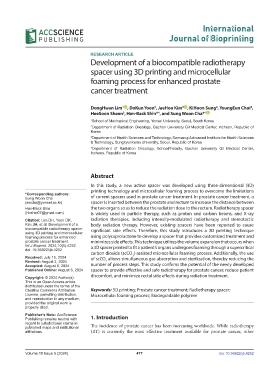Page 485 - IJB-10-5
P. 485
International
Journal of Bioprinting
RESEARCH ARTICLE
Development of a biocompatible radiotherapy
spacer using 3D printing and microcellular
foaming process for enhanced prostate
cancer treatment
DongHwan Lim 1 id , DoKun Yoon , JaeHoo Kim 3 id , KiHoon Sung , YoungEun Choi ,
4
4
2
HeeSoon Sheen , Han-Back Shin* , and Sung Woon Cha* 1 id
4
3
1 School of Mechanical Engineering, Yonsei University, Seoul, South Korea
2 Department of Radiation Oncology, Gachon University Gil Medical Center, Incheon, Republic of
Korea
3 Department of Health Sciences and Technology, Samsung Advanced Institute for Health Sciences
& Technology, Sungkyunkwan University, Seoul, Republic of Korea
4 Department of Radiation Oncology, School/Faculty, Gachon University Gil Medical Center,
Incheon, Republic of Korea
Abstract
In this study, a new active spacer was developed using three-dimensional (3D)
printing technology and microcellular foaming process to overcome the limitations
*Corresponding authors:
Sung Woon Cha of current spacers used in prostate cancer treatment. In prostate cancer treatment, a
(swcha@yonsei.ac.kr) spacer is inserted between the prostate and rectum to increase the distance between
Han-Back Shin the two organs so as to reduce the radiation dose to the rectum. Radiotherapy spacer
(hbshin07@gmail.com) is widely used in particle therapy, such as proton and carbon beams, and X-ray
Citation: Lim DH, Yoon DK, radiation therapies, including intensity-modulated radiotherapy and stereotactic
Kim JH, et al. Development of a body radiation therapy. However, existing spacers have been reported to cause
biocompatible radiotherapy spacer significant side effects. Therefore, this study introduces a 3D printing technique
using 3D printing and microcellular
foaming process for enhanced using polycaprolactone to develop a spacer that provides customized treatment and
prostate cancer treatment. minimizes side effects. This technique utilizes the volume expansion that occurs when
Int J Bioprint. 2024;10(5):4252. a 3D spacer printed to fit a patient’s organs undergoes foaming through a supercritical
doi: 10.36922/ijb.4252
carbon dioxide (scCO )-assisted microcellular foaming process. Additionally, the use
2
Received: July 15, 2024 of scCO allows simultaneous gas absorption and sterilization, thereby reducing the
Revised: August 3, 2024 2
Accepted: August 5, 2024 number of process steps. This study confirms the potential of the newly developed
Published Online: August 6, 2024 spacer to provide effective and safe radiotherapy for prostate cancer, reduce patient
discomfort, and minimize rectal side effects during radiation treatment.
Copyright: © 2024 Author(s).
This is an Open Access article
distributed under the terms of the
Creative Commons Attribution Keywords: 3D printing; Prostate cancer treatment; Radiotherapy spacer;
License, permitting distribution, Microcellular foaming process; Biodegradable polymer
and reproduction in any medium,
provided the original work is
properly cited.
Publisher’s Note: AccScience
Publishing remains neutral with 1. Introduction
regard to jurisdictional claims in
published maps and institutional The incidence of prostate cancer has been increasing worldwide. While radiotherapy
affiliations. (RT) is currently the most effective treatment available for prostate cancer, other
Volume 10 Issue 5 (2024) 477 doi: 10.36922/ijb.4252

